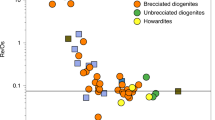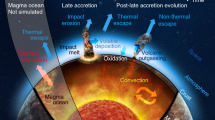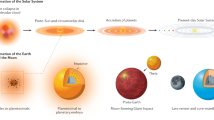Abstract
Accretion left the terrestrial planets depleted in volatile components. Here I examine evidence for the hypothesis that the Moon and the Earth were essentially dry immediately after the formation of the Moon—by a giant impact on the proto-Earth—and only much later gained volatiles through accretion of wet material delivered from beyond the asteroid belt. This view is supported by U–Pb and I–Xe chronologies, which show that water delivery peaked ∼100 million years after the isolation of the Solar System. Introduction of water into the terrestrial mantle triggered plate tectonics, which may have been crucial for the emergence of life. This mechanism may also have worked for the young Venus, but seems to have failed for Mars.
This is a preview of subscription content, access via your institution
Access options
Subscribe to this journal
Receive 51 print issues and online access
$199.00 per year
only $3.90 per issue
Buy this article
- Purchase on Springer Link
- Instant access to full article PDF
Prices may be subject to local taxes which are calculated during checkout






Similar content being viewed by others
References
Drake, M. J. & Righter, K. Determining the composition of the Earth. Nature 416, 39–44 (2002)
Michael, P. Regionally distinctive sources of depleted MORB: evidence from trace elements and H2O. Earth Planet. Sci. Lett. 131, 301–320 (1995)Brackets the geochemical behaviour of water during magma generation between that of rare-earth elements lanthanum and neodymium.
Saal, A. E., Hauri, E. H., Langmuir, C. H. & Perfit, M. R. Vapour undersaturation in primitive mid-ocean-ridge basalt and the volatile content of Earth's upper mantle. Nature 419, 451–455 (2002)
Marty, B. & Yokochi, R. in Water in Nominally Anhydrous Minerals (eds Keppler, H. & Smyth, J. R) 421–450 (Rev. Mineral. Geochem. 62, Mineral. Soc. Am., 2006)
McDonough, W. F. & Ireland, T. R. Intraplate origin of komatiites inferred from trace-elements in glass inclusions. Nature 365, 432–434 (1993)
Lahaye, Y., Barnes, S. J., Frick, L. R. & Lambert, D. D. Re-Os isotopic study of komatiitic volcanism and magmatic sulfide formation in the southern Abitibi greenstone belt, Ontario, Canada. Can. Mineral. 39, 473–490 (2001)
Bercovici, D. & Karato, S. I. Whole-mantle convection and the transition-zone water filter. Nature 425, 39–44 (2003)
Bolfan-Casanova, N., Keppler, H. & Rubie, D. C. Water partitioning between nominally anhydrous minerals in the MgO-SiO2-H2O system up to 24 GPa: implications for the distribution of water in the Earth's mantle. Earth Planet. Sci. Lett. 182, 209–221 (2000)
Ingrin, J. & Blanchard, M. in Water in Nominally Anhydrous Minerals (eds Keppler, H. & Smyth, J. R.) 291–320 (Rev. Mineral. Geochem. 62, Mineral. Soc. Am., 2006)
Wyatt, M. C. Evolution of debris disks. Annu. Rev. Astron. Astrophys. 46, 339–383 (2008)
Stevenson, D. J. & Lunine, J. I. Rapid formation of Jupiter by diffusive redistribution of water vapor in the solar nebula. Icarus 75, 146–155 (1988)
Ciesla, F. J. & Cuzzi, J. N. The evolution of the water distribution in a viscous protoplanetary disk. Icarus 181, 178–204 (2006)
Lodders, K. Solar system abundances and condensation temperatures of the elements. Astrophys. J. 591, 1220–1247 (2003)
Taylor, S. R. in Origin of the Moon (eds Hartmann, W. K., Phillips, R. J. & Taylor, G. J.) 125–143 (Lunar Planet. Inst., 1984)
Jochum, K. P., Hofmann, A. W., Ito, E., Seufert, H. M. & White, W. M. K. U and Th in mid-ocean ridge basalt glasses and heat production, K/U and K/Rb in the mantle. Nature 306, 431–436 (1983)
Wasserburg, G. J., MacDonald, G. J. F., Hoyle, F. & Fowler, W. A. Relative contributions of uranium, thorium, and potassium to heat production in the Earth. Science 143, 465–467 (1964)
Lodders, K. A survey of shergottite, nakhlite and chassigny meteorites whole-rock compositions. Meteorit. Planet. Sci. 33, A183–A190 (1998)
Dreibus, G. & Palme, H. Cosmochemical constraints on the sulfur content in the Earth's core. Geochim. Cosmochim. Acta 60, 1125–1130 (1996)
O'Neil, H. & Palme, H. in The Earth's Mantle, Composition, Structure and Evolution (ed. Jackson, I.) 3–126 (Cambridge Univ. Press, 1998)
Humayun, M. & Clayton, R. N. Potassium isotope cosmochemistry: genetic implications of volatile element depletion. Geochim. Cosmochim. Acta 59, 2131–2148 (1995)This shows that the lack of fractionation between the isotopes of potassium among planetary bodies argues against major devolatization of planetary bodies by impacts.
Hunten, D. M., Pepin, R. O. & Walker, J. C. G. Mass fractionation in hydrodynamic escape. Icarus 69, 532–549 (1987)
Moynier, F., Albarède, F. & Herzog, G. Isotopic fractionation of Zn, Cu and Fe in lunar materials. Geochim. Cosmochim. Acta 70, 6103–6117 (2006)
Richter, F. M. Timescales determining the degree of kinetic isotope fractionation by evaporation and condensation. Geochim. Cosmochim. Acta 68, 4971–4992 (2004)
Moynier, F. et al. Europium isotopic variations in Allende CAIs and the nature of mass-dependent fractionation in the solar nebula. Geochim. Cosmochim. Acta 70, 4287–4294 (2006)
Gast, P. W. Limitations on the composition of the upper mantle. J. Geophys. Res. 65, 1287–1297 (1960)
McDonough, W. F., Sun, S. S., Ringwood, A. E., Jagoutz, E. & Hofmann, A. W. Potassium, rubidium, and cesium in the Earth and Moon and the evolution of the mantle of the Earth. Geochim. Cosmochim. Acta 56, 1001–1012 (1992)
Grossman, L. Condensation in the primitive solar nebula. Geochim. Cosmochim. Acta 36, 597–619 (1972)
Larimer, J. W. Chemical fractionations in meteorites – I. Condensation of the elements. Geochim. Cosmochim. Acta 31, 1215–1238 (1967)
Wulfsberg, G. Inorganic Chemistry (University Science Books, 2000)
Ganapathy, R. & Anders, E. Bulk compositions of the Moon and Earth, estimated from meteorites. Proc. Lunar Planet Sci. Conf. 5, 1181–1206 (1974)
Davis, A. M. & Richter, F. M. in Treatise on Geochemistry Vol. 2 (ed. Davis, A. M.) 407–430 (Elsevier, 2006)
Wänke, H. Constitution of terrestrial planets. Phil. Trans. R. Soc. Lond. B 303, 287–302 (1981)
Ebel, D. S. & Grossman, L. Condensation in dust-enriched systems. Geochim. Cosmochim. Acta 64, 339–366 (2000)
Chou, C. L. Fractionation of siderophile elements in the Earth's upper mantle. Proc. Lunar Planet. Sci. Conf. 9, 219–230 (1978)
Wetherill, G. W. in Origin of the Moon (eds Hartmann, W. K., Phillips, R. J. & Taylor, G. J.) 519–551 (Lunar Planet. Inst., 1986)
O'Brien, D. P., Morbidelli, A. & Levison, H. F. Terrestrial planet formation with strong dynamical friction. Icarus 184, 39–58 (2006)A remarkable attempt at understanding the history of water transfer across the Solar System during planetary accretion.
Owen, T. & Bar-Nun, A. Comets, impacts, and atmospheres. Icarus 116, 215–226 (1995)
Bockelée-Morvan, D. et al. Deuterated water in comet C/1996 B2 (Hyakutake) and its implications for the origin of comets. Icarus 133, 147–162 (1998)
Huebner, W. Composition of comets: observations and models. Earth Moon Planets 89, 179–195 (2000)
Lécuyer, C., Gillet, P. & Robert, F. The hydrogen isotope composition of seawater and the global water cycle. Chem. Geol. 145, 249–261 (1998)
Robert, F. The origin of water on Earth. Science 293, 1056–1058 (2001)
Morbidelli, A. et al. Source regions and time scales for the delivery of water to the Earth. Meteorit. Planet. Sci. 35, 1309–1320 (2000)A breakthrough paper on accretion dynamics, demonstrating the prominence of water delivery to the inner Solar System from Jupiter and beyond.
Raymond, S. N., Quinn, T. & Lunine, J. I. High-resolution simulations of the final assembly of Earth-like planets I. Terrestrial accretion and dynamics. Icarus 183, 265–282 (2006)
Muralidharan, K., Deymier, P., Stimpfl, M., de Leeuw, N. H. & Drake, M. J. Origin of water in the inner Solar System: a kinetic Monte Carlo study of water adsorption on forsterite. Icarus 198, 400–407 (2008)
Touboul, M., Kleine, T., Bourdon, B., Palme, H. & Wieler, R. Late formation and prolonged differentiation of the Moon inferred from W isotopes in lunar metals. Nature 450, 1206–1209 (2007)An outstanding 182Hf–182W data set critical for the discussion of the early lunar chronology.
Kleine, T., Münker, C., Mezger, K. & Palme, H. Rapid accretion and early core formation on asteroids and the terrestrial planets from Hf–W chronometry. Nature 418, 952–955 (2002)
Yin, Q. et al. A short timescale for terrestrial planet formation from Hf-W chronometry of meteorites. Nature 418, 949–952 (2002)
Warren, P. H. in Treatise on Geochemistry Vol. 1 (ed. Davis, A. M.) 559–599 (Elsevier, 2005)
Honda, M., McDougall, I., Patterson, D. B., Doulgeris, A. & Clague, D. Possible solar noble-gas component in Hawaiian basalts. Nature 349, 149–151 (1991)
Caffee, M. W. et al. Primordial noble gases from Earth's mantle: identification of a primitive volatile component. Science 285, 2115–2118 (1999)The first incontrovertible evidence that the Earth’s atmosphere and mantle have different abundances of stable xenon isotopes.
Kunz, J. Is there solar argon in the Earth's mantle? Nature 399, 649–650 (1999)
Trieloff, M., Kunz, J. & Allègre, C. J. Noble gas systematics of the Reunion mantle plume source and the origin of primordial noble gases in Earth's mantle. Earth Planet. Sci. Lett. 200, 297–313 (2002)
Saal, A. E. et al. Volatile content of lunar volcanic glasses and the presence of water in the Moon’s interior. Nature 454, 192–196 (2008)
Albarede, F. & Juteau, M. Unscrambling the lead model ages. Geochim. Cosmochim. Acta 48, 207–212 (1984)
Galer, S. J. G. & Goldstein, S. L. in Earth Processes: Reading the Isotopic Code (eds Basu, A. & Hart, S. R.) 75–98 (Geophys. Monogr. 95, AGU, 1996)
Palme, H. & O'Neill, H. S. C. in Treatise on Geochemistry Vol. 2 (ed. Carlson, R. W.) 1–38 (Elsevier, 2005)
Premo, W. R., Tatsumoto, M., Misawa, K., Nakamura, N. & Kita, N. T. in Planetary Petrology and Geochemistry: The Lawrence A. Taylor 60th Birthday volume (eds Snyder, G. A., Neal, C. R. & Ernst, W. G.) 207–240 (Bellwether, 1999)
Pepin, R. O. & Phinney, D. The formation interval of the Earth. Lunar Planet. Sci. VII, 683–684 (1976)
Allegre, C. J., Manhes, G. & Gopel, C. The age of the Earth. Geochim. Cosmochim. Acta 59, 1445–1456 (1995)
Ozima, M. & Podosek, F. A. Formation age of Earth from 129I/127I and 244Pu/238U systematics and the missing Xe. J. Geophys. Res. B 104, 25493–25499 (1999)A reference paper on how short-lived radioactivities based on Xe isotopes constrain the age of the Earth and of its atmosphere.
Harper, C. L. & Jacobsen, S. B. Noble gases and Earth's accretion. Science 273, 1814–1818 (1996)
Boyet, M. et al. 142Nd evidence for early Earth differentiation. Earth Planet. Sci. Lett. 214, 427–442 (2003)
Gurnis, M. & Davies, G. F. The effect of depth-dependent viscosity on convective mixing in the mantle and the possible survival of primitive mantle. Geophys. Res. Lett. 13, 541–544 (1986)
Shieh, S. R., Mao, H.-k., Hemley, R. J. & Ming, L. C. Decomposition of phase D in the lower mantle and the fate of dense hydrous silicates in subducting slabs. Earth Planet. Sci. Lett. 159, 13–23 (1998)
Kawamoto, T. in Water in Nominally Anhydrous Minerals (eds Keppler, H. & Smyth, J. R.) 273–289 (Rev. Mineral. Geochem. 62, Mineral. Soc. Am., 2006)
Smyth, J. R. in Water in Nominally Anhydrous Minerals 85–115 (Rev. Mineral. Geochem. 62, Mineral. Soc. Am., 2006)
Lawrence, J. F. & Wysession, M. E. in Earth's Deep Water Cycle (eds Jacobsen, S. D. & van der Lee, S.) 251–260 (AGU Monograph 168, Am. Geophys. Un., 2006)
Hirth, G. & Kohlstedt, D. L. Water in the oceanic upper mantle: implications for rheology, melt extraction and the evolution of the lithosphere. Earth Planet. Sci. Lett. 144, 93–108 (1996)
Kohlstedt, D. L., Evans, B. & Mackwell, S. J. Strength of the lithosphere — constraints imposed by laboratory experiments. J. Geophys. Res. B 100, 17587–17602 (1995)
O'Neill, C., Jellinek, A. M. & Lenardic, A. Conditions for the onset of plate tectonics on terrestrial planets and moons. Earth Planet. Sci. Lett. 261, 20–32 (2007)
Albarède, F. in Earth's Deep Mantle: Structure, Composition, and Evolution (eds van der Hilst, R. D., Bass, J., Matas, J. & Trampert, J.) 27–46 (Geophys. Monogr. 160, Am. Geophys. Union, 2005)
Rosenblatt, P., Pinet, P. C. & Thouvenot, E. Comparative hypsometric analysis of Earth and Venus. Geophys. Res. Lett. 21, 465–468 (1994)
Hauck, S. A., Phillips, R. J. & Price, M. H. Venus: crater distribution and plains resurfacing models. J. Geophys. Res. E 103, 13635–13642 (1998)
Phillips, R. J. et al. Impact craters and Venus resurfacing history. J. Geophys. Res. 97, 15923–15948 (1992)
Barabash, S. et al. The loss of ions from Venus through the plasma wake. Nature 450, 650–653 (2007)
Pepin, R. O. On the origin and early evolution of terrestrial planet atmospheres and meteoritic volatiles. Icarus 92, 2–79 (1991)
Lunine, J. I., Chambers, J., Morbidelli, A. & Leshin, L. A. The origin of water on Mars. Icarus 165, 1–8 (2003)
Carr, M. H. & Wänke, H. Earth and Mars: water inventories as clues to accretional histories. Icarus 98, 61–71 (1992)
Jakosky, B. M. & Phillips, R. J. Mars' volatile and climate history. Nature 412, 237–244 (2001)
McSween, H. Y. et al. Geochemical evidence for magmatic water within Mars from pyroxenes in the Shergotty meteorite. Nature 409, 487–490 (2001)
Medard, E. & Grove, T. L. Early hydrous melting and degassing of the Martian interior. J. Geophys. Res. Planets 111 10.1029/2006JE002742 (2006)
Bouvier, A., Blichert-Toft, J., Vervoort, J. D. & Albarede, F. The age of SNC meteorites and the antiquity of the Martian surface. Earth Planet. Sci. Lett. 240, 221–233 (2005)
Nimmo, F. & Stevenson, D. J. Influence of early plate tectonics on the thermal evolution and magnetic field of Mars. J. Geophys. Res. 105, 11969–11979 (2000)
Sleep, N. H., Meibom, A., Fridriksson, T., Coleman, R. G. & Bird, D. K. H2-rich fluids from serpentinization: geochemical and biotic implications. Proc. Natl Acad. Sci. USA 101, 12818–12823 (2004)
Albarede, F. & Blichert-Toft, J. in Origins of Life: Self-Organization and/or Biological Evolution? (eds Gerin, M. & Maurel, M. C.) 1–12 (EDP Sciences, Paris, 2009)
Pahlevan, K. & Stevenson, D. J. Equilibration in the aftermath of the lunar-forming giant impact. Earth Planet. Sci. Lett. 262, 438–449 (2007)
Luck, J.-M., Othman, D. B. & Albarede, F. Zn and Cu isotopic variations in chondrites and iron meteorites: early solar nebula reservoirs and parent-body processes. Geochim. Cosmochim. Acta 69, 5351–5363 (2005)The strange behaviour of two non-traditional stable isotope systems and their bearing on planetary accretion.
Fromang, S., Terquem, C. & Balbus, S. The ionization fraction in alpha models of protoplanetary disks. Mon. Not. R. Astron. Soc. 329, 18–28 (2002)
Tatsumoto, M., Knight, R. J. & Allegre, C. J. Time differences in formation of meteorites as determined from ratio of lead-207 to lead-206. Science 180, 1279–1283 (1973)
Acknowledgements
I am grateful to J. Blichert-Toft, S. Labrosse and H. Ohmoto for suggestions on the manuscript. Reviews by A. Morbidelli, M. Humayun and M. Drake were particularly helpful. Thanks to A. Levander and C.-T. Lee, I was able to spend enough quiet time at Rice University to bring this work to completion. This work was supported by the Agence Nationale de la Recherche and the Programme National de Planétologie (INSU-CEA).
Author information
Authors and Affiliations
Corresponding author
Rights and permissions
About this article
Cite this article
Albarède, F. Volatile accretion history of the terrestrial planets and dynamic implications. Nature 461, 1227–1233 (2009). https://doi.org/10.1038/nature08477
Issue Date:
DOI: https://doi.org/10.1038/nature08477
This article is cited by
-
Tetracarbonates in silicate melts may be at the origin of a deep carbon reservoir in the deep Earth
Communications Earth & Environment (2023)
-
First-principles calculations of equilibrium Ga isotope fractionations between several important Ga-bearing minerals and aqueous solutions
Scientific Reports (2023)
-
Evidence for a rosiaite-structured high-pressure silica phase and its relation to lamellar amorphization in quartz
Nature Communications (2023)
-
Earth shaped by primordial H2 atmospheres
Nature (2023)
-
Magma Ocean, Water, and the Early Atmosphere of Venus
Space Science Reviews (2023)
Comments
By submitting a comment you agree to abide by our Terms and Community Guidelines. If you find something abusive or that does not comply with our terms or guidelines please flag it as inappropriate.



